Glass Paperweights
By Art Elder
“The Crown Jewels for Collectors” – that’s what Paul Hollister wrote about fine glass paperweights. He was one of the foremost scholars of 17th to 19th century glass studies, glass paperweights, and contemporary studio art glass. Paperweights are considered the most collectable of 19th century glass items, and also the most challenging of the glass arts to make. Fine glass paperweights are, indeed, rare treasures.
Most antique paperweights of quality were made as a sideline by one of three French factories for just 10-15 years in the mid-1800s. It is estimated that only about 25,000-30,000 remain today, with many tightly held in museum collections. Fine contemporary paperweights are made by a limited number of studio artists and are sold either by the artist, or by a small group of specialty dealers.
The mid-to-late 1800s were sentimental and romantic times, heralded by an emerging middle class resulting from the matured Industrial Revolution. Letter writing became a fad, and paperweights were sold in stationery stores as an attractive accessory to desk sets that included pens, inkwells, blotters and fine stationery. The first glass paperweight was made in 1845 by Venetian glassmakers in response to the letter-writing fad. They could have been made 300 years earlier because the techniques were known, but paper was then a rare commodity and there was no need for a paperweight. They are the perfect example of form following function.
The finest were made by the French factories of Baccarat, Clichy, and Saint Louis for only 10-15 years. By 1855-1860, their production in France sharply fell off as the glass factories moved on to focus on producing other objects.
American made paperweights followed from 1851 into the late 1880s by the Boston and Sandwich Glass Company and the New England Glass Company – and more rarely by makers including Dorflinger, Mount Washington, Gillinder and Whithall Tatum companies. Their glassmakers were mainly European immigrants already skilled in the craft, which explains why American paperweights are somewhat imitative of the European. What American paperweights may have lacked in quality, they more than made up for in creativity and ingenuity, which makes them even more charming to their collectors.
Paperweights were also made in limited numbers in the late 19th century by Bohemian glassworks (mostly unnamed) and more rarely by the Belgians (Val Saint Lambert), the English (Bacchus), and a very few by the Russians.
Most 19th century paperweights were made in factories where glassmakers were unfortunately not identified.
After 1890, very few quality paperweights were being made until the 1950s when the art was revived by Paul Ysart in Scotland and Charles Kazian in the U.S. The techniques had to be re-learned, as they were considered a trade secret by the old glassmakers.
After the revival of paperweights in the 1950s, factory production began in Scotland by the Vasart, Strathearn, Caithness, and Perthshire factories; and in England by Whitefriars. Production quickly spread to the U.S. to studio artists that now number over 30 who are actively creating fine paperweights. Fine contemporary paperweights are also being crafted by studio artists in Canada, England, Scotland, France, Japan and New Zealand.
Contemporary individual artists have mastered the craft and taken it to new heights unknown to the original masters. Today’s paperweights by these artists are exceptionally well-crafted, creative, and beautiful examples of fine glass art. To make a precise paperweight, the artist needs to have complete control over the glass. Most artists work alone in small studios, where their creative talents allow them to design infinite, interesting, and innovative creations. Many contemporary glass artists, although having the technical skills to reproduce a design faithfully, will frequently produce very limited editions of from one to five paperweights of a single design.
Large numbers of simple paperweights are mass-produced in China, Italy, and other locations. These are often found in gift shops and eBay auctions, but are not considered collectible by discerning collectors.
There are three basic types of paperweights. The first, termed “sulphides,” are commemorative objects, featuring encased molded ceramic plaques of a person’s profile, in bas-relief.
These were followed by the “millefiori” (Italian, meaning “thousand flowers”) featuring encased sliced colorful glass canes set in geometric patterns. Millefiori has been known for almost 2,000 years, but it was previously used as jewelry, or to decorate glass plates and vessels.
“Lampwork” (recently termed “flamework”) uses a fine torch to sculpt from colored glass, lifelike flowers, or animals/insects, which are then encased. These became very popular because of the Victorian “language of flowers” in which flowers were used to convey messages. Contemporary paperweight artists are crafting realistic objects of floral bouquets, insects, or animals that are often mistaken for being real.
Paperweight Collecting
Fine glass paperweights originally were used functionally to hold down paper, but collectors now consider them as collectible glass art objects and value them for their beauty, creativity, and rarity.
Collecting paperweights began shortly after their production ceased in the 1890s, primarily by aristocracy and royalty. It is impressive that these very privileged individuals chose to collect paperweights, which were relatively inexpensive at the time. They must have recognized the beauty and sentimentality of these well-designed and
well-crafted objects.
Collecting paperweights became more common in the early 20th century, when some outstanding collections were formed. They were recognized as a legitimate form of the decorative arts in 1925, when Sotheby’s conducted the first major auction of paperweights. The number of collectors increased markedly after 1953, when the Paperweight Collectors Association was formed. The Paperweight Collectors Association hosts biennial conventions, bringing together collectors, artists, and dealers. Additionally, 19 regional collectors’ organizations provide social, educational, and buying opportunities for collectors in local areas across the U.S.
Because they are rare, fine paperweights tend to be unknown to the general public. When someone is first introduced to these, there is a universal attraction and almost magical fascination with them. Most novice viewers are astounded by their beauty and extreme precision. Some people actually become speechless. Others cannot believe an encased glass floral bouquet is not real.
Amory Houghton built an outstanding collection over a 50-year span, beginning in the early 1930s. Houghton was chairman emeritus of Corning Glass Works. He spent his life in the glass industry, yet with an exposure to the many different forms of glass art, he chose to collect paperweights. The Houghton Collection of 288 paperweights forms the nucleus of the paperweight collection at the Corning Museum of Glass, which has grown through gifts and bequests.
Evangeline Bergstrom, the wife of a wealthy paper manufacturer, collected about 700 weights from 1935 to 1944. Her collection formed the nucleus of the Bergstrom-Mahler Museum, in Neenah, Wisconsin, which opened in 1959. Its collection has now grown to more than 2,200 paperweights through donations, bequests, and acquisitions.
Arthur Rubloff, the developer of the Miracle Mile in Chicago, was introduced to paperweights in the early 1950s and proceeded to build one of the world’s greatest collections. He was known to buy only the very best quality available, and price was not a concern. In 1978, he donated 1,472 paperweights from his collection to the Art Institute of Chicago.
These exceptional collectors had two things in common: first, a true passion for collecting and second, the privilege of having sufficient financial resources to build extensive collections. Today, access to high-end collections in museums help to drive the appreciation of this unique art form for everyone.
Smaller, regional museums also exhibit paperweights, including the Fuller Collection at the Currier Museum of Art in Manchester, New Hampshire; the Wheeler Collection at Smith College in Northampton, Massachusetts; and the Smith Collection at the Forsyth Center Galleries at Texas A&M University in College Station, Texas.
Judging Value
Judging the value of these rare and unusual objects is a complex issue. The primary factors influencing the value of antique paperweights include:
• Maker (French are generally the most valuable)
• Rarity of the design (the more rare the design, the more valuable)
• Symmetry and centering of the design (the more symmetrical, the more valuable)
• Internal flaws such as bubbles, tilted canes, or striations (fewer flaws are more valuable)
• Size (most vary from about 21/2 inches to 31/4 inches diameter – the larger the better – exceptions are miniatures, which are 2 inches or smaller in diameter)
• Condition of the exterior (the less restoration and scratches/chips the better)
• Overall visual impact (or the “wow” factor)
• Provenance (only an issue if it is from one of the few historic collections)
Perceived value is always a trade-off of all these eight factors. They are important to collectors, who, as individuals, may value one factor above others. Because paperweights were all handmade, there are usually variations in each of them, which affect the value.
The cost of contemporary paperweights also depends upon the same judgement factors as the antique paperweights. They are usually less expensive than antiques. Well-made factory paperweights by Perthshire or similar makers can be bought for $200-$400. Well-made paperweights by studio artists will cost $500-$900. Top name studio artists paperweights will cost $900-$2,500, with exceptional examples costing $5,000-$7,500. Some very exceptional examples may sell for $10,000 or more.
Paperweights have an enthusiastic following by collectors who appreciate their rarity, beauty, precision, sentimentality, and interesting history. Have a look – see what they’re enjoying, and join the fun!
For more information, go to the website of the Paperweight Collectors Association, paperweight.org
Art has collected paperweights for over 40 years, has been a member of the PCA for 35 years, and was past president of the regional PCA Texas organization. He has authored several published books about paperweights and collecting, as well as numerous magazine articles. Art thanks Zoë Switzer for her helpful assistance.


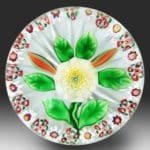
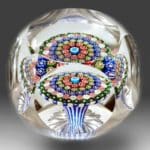
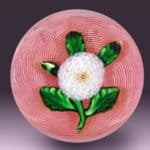
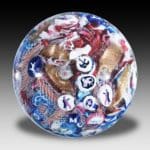
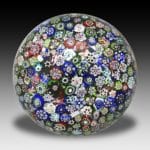
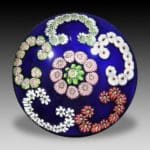
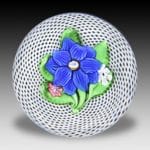
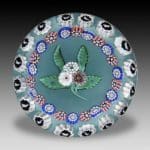
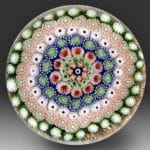
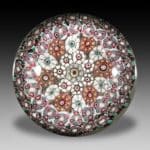
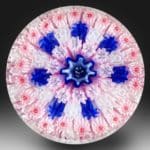


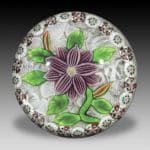

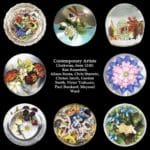



Related posts: